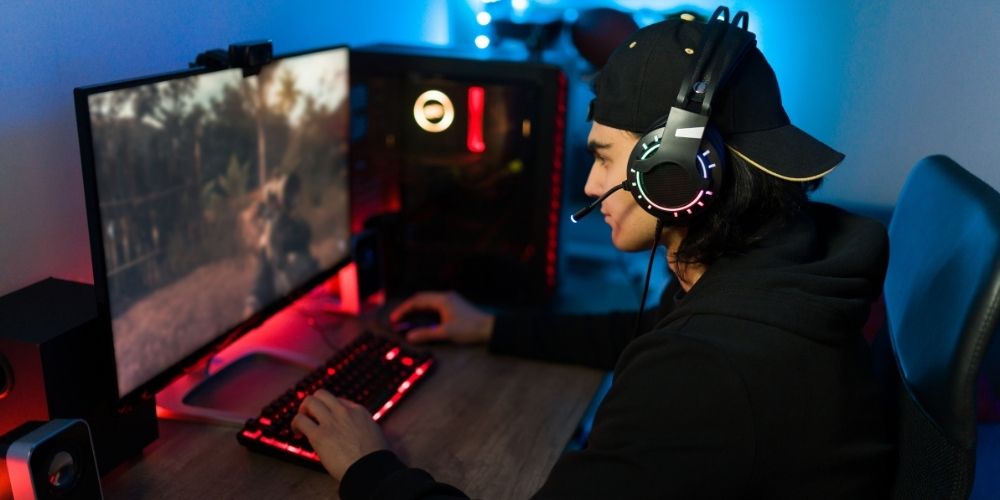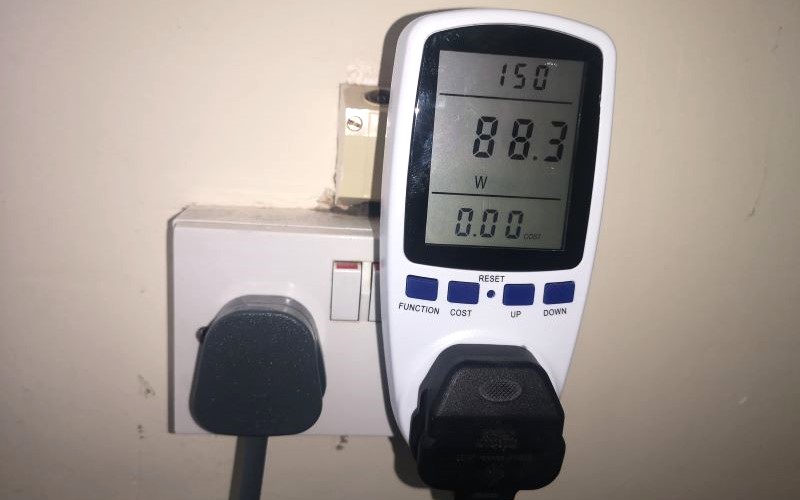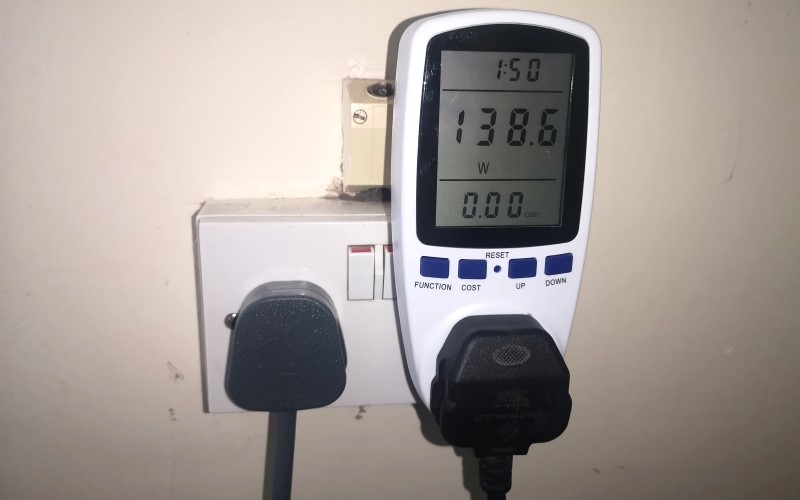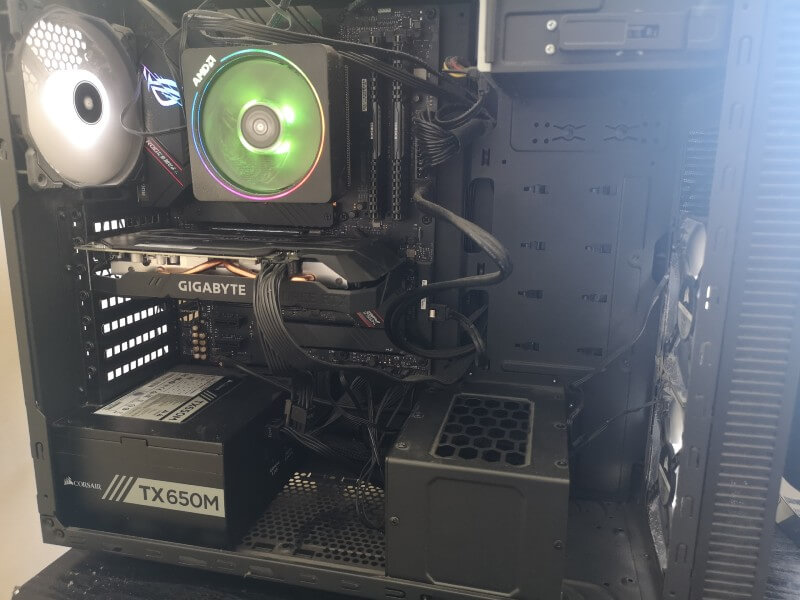If you own a gaming PC, you’ll know that they’re pretty complex systems that can handle a lot of stress. Even budget gaming PCs are packed with a lot more capability than a regular tower used only for work.
For a gaming PC to work properly, it needs a lot of power – but how much exactly?
Is your gaming habit costing you more than you realize on your electricity bill, or can enjoy marathon gaming sessions without any fear about the costs involved?

Let’s take a bit of a dive. But. spoilers up front – there’s no definitive answer when it comes to gaming PCs. The power used depends on the various components that make up your PC, and what you’re using it for at any given time, but I’ll do my best to explain that and give the best averages I can.
How Much Power Does A Gaming PC Use?
The power that a gaming PC uses depends entirely on the spec of the PC and what it’s being used for. A top-end PC working at its hardest could easily use more than 1,000 watts, while a budget PC may only use 400 watts.
Firstly, it’s important to explain how a gaming PC works. A gaming PC isn’t a single electrical item, but it’s made up of various different components, including:
- Motherboard – the backbone that ties the components together
- Processor – the brain of the PC
- Storage – either a hard disk drive (HDD) or a solid-state drive (SSD), sometimes both
- RAM – the short-term memory that your computer uses to manage tasks
- Graphics card – a powerful tool that is responsible for creating the graphics in games
- Cooling – either air or water cooling to stop the other components from overheating
- Power supply – manages the electricity that all the other components need
- Monitor – one or more screens
Those are the basics of a gaming PC, but there may be other components too. Some people still use a CD, DVD, or Blu-Ray drive, while others may have extra cards in their PC for specific tasks, such as a streaming card used to record gaming footage live online.
And of course, many gaming PCs also have LED lighting built into the case.
Now within each of those above, there are loads of different options which makes it virtually impossible to work out how much electricity your individual PC uses. The best way to do that would be to plug it into an Electricity Usage Monitor and see how much it’s using.

Of course, that won’t help you if you haven’t built the PC yet. But, we can work with averages.
So as a rough guide, here’s a selection of key components and the power that they typically draw:
| Spec | Rating | Model example | Watts used (low demand) | Watts used (maxed out) |
|---|---|---|---|---|
| Processor | High-end | Intel Core i7-12700K | 125W | 190W |
| Processor | Mid-range | Intel Core i5-11600 | 40W | 65W |
| Processor | Budget | Intel Core i5-8300H | 30W | 45W |
| RAM | High-end | 32GB 3200mhz | 9W | 12W |
| RAM | Mid-range | 16GB 3000mhz | 6W | 9W |
| RAM | Budget | 8GB 2600mhz | 3W | 6W |
| Storage | High-end | 2TB NVME SSD | 1W | 10W |
| Storage | Mid-range | 1TB SATA SSD | 0.25W | 9W |
| Storage | Budget | 1TB HDD | 6.5W | 20W |
| Graphics Card | High-end | GeForce 3080 Ti | 30W | 350W |
| Graphics Card | Mid-range | GeForce 2060 | 12W | 175W |
| Graphics Card | Budget | GeForce 1060 | 9W | 120W |



My own gaming PC is mid-spec. I have a Ryzen 9 3900 processor and an RTX 2060 graphics card, so it’s plenty powerful. I ran some tests to see how much power it was using.
When I first switched it on, it was averaging 85 to 100 watts – captured at 88.3.
I then loaded up YouTube and watched a 4K video, and the consumption jumped up to around 140 watts – the second image of 138.6 watts was during this time.
Then I loaded up the Resident Evil 4 Remake Chainsaw Demo, running at 4K resolution. That took the power consumption up to 233.1 watts.
These are all below the averages you’d predict, but I imagine if I left the tests running for a long time then the consumption may creep up as the processor took on more tasks.
Processors

The processor is one of the most important parts of your gaming PC. There are two main processor manufacturers, Intel, and AMD. Let’s focus just on Intel for now.
With Intel, most gaming PCs will use their Core range, which means either a Core i3, Core i5, Core i7, and on rare occasions Core i9, although they’re usually reserved for the very best PCs, not many gamers stretch their budget to an i9 (and they don’t need to).
But then, you also have the generation, which is the year they were released. New gaming PCs will likely use 11th or 12th-generation processors, but many people still game on much older models.
And if that wasn’t enough, there’s then the product suffix which tells you what the processor is designed for. There are more than 15 different suffixes, including K (one of the best for gamers), G (discreet graphics included), and U (designed more for mobile power, more for laptops than desktops).
The point is that even just within processors there are hundreds of different model combinations, and each one has its own power draw. Then there are all the different graphics cards models, all the different storage types, all the different RAM sizes and speeds… giving an accurate idea of power draw is almost impossible!
Storage

Storage is the only spec where components that are considered better actually draw less power – NVME drives are the fastest you can get but they use fewer watts than HDDs, although the numbers are quite minimal.
Graphics Cards

With graphics cards, there’s a huge difference between idle and when in use. If you aren’t actively playing a game, your PC doesn’t need to use the graphics card and so it’ll draw a lot less power. But as soon as you put it to use, it’ll kick in and probably double the power your entire PC is drawing.
Motherboard

The motherboard is one of the bigger power draws. Generally, for a gaming PC, expect it to draw 80 watts, although some budget ones may draw around 40 watts. Most of the power draw for a gaming PC comes from the motherboard, processor and graphics card combined.
Monitor

A gaming PC on its own isn’t much use if you don’t have a monitor to plug it in. Sure, all that LED lighting might look pretty when you boot it up, but to then do anything at all you’re going to need a monitor hooked up.
There are two main screen types when it comes to monitors – LED and OLED. You can still sometimes pick up a cheap LCD but when it comes to gaming, it tends to be between the more modern LED screens or an OLED.
Then there’s the size of the screen to factor in as well. Most gaming monitors are either 21.5″, 24″, 27″ or 32″ but you can then get ultra-wide 34″ or even extreme 49″ monitors.
Here’s a quick guide to some typical monitor wattages.
| Screen Size | LED | OLED |
|---|---|---|
| 21.5″ | 25 watts | 38 watts |
| 24″ | 40 watts | N/A |
| 27″ | 45 watts | 72 watts |
| 32″ | 55 watts | 84 watts |
| 34″ ultra-wide | 80 watts | 200 watts |
| 49″ ultra-wide | 108 watts | N/A |
Don’t forget that a lot of gamers prefer to use more than one monitor, so if you want to double (or even triple) up then you’ll need to add on the watts for each individual monitor.

I own a couple of 22-inch PC monitors, so I tested how much power they used when hooked up to my PC. They averaged around 24 watts for the duration of the test – 23.7 as I captured the photo. So the table above is pretty accurate.
Power Supply

The wattage of your PC’s power supply isn’t a static number. It’s defined by the rest of the components of your PC. Depending on the parts your PC has, the power supply will then draw enough watts to provide that power to each individual part.
However, they’re not immaculately efficient at doing that. On average they’ll draw an extra 20% of power in order to do their job. So, if your gaming PC’s spec totals around 300 watts, then the power supply will draw a total of 360 watts – 300 plus the 20% extra (60).
It can get a little confusing since power supplies are advertised with a wattage rating but that’s not how much they draw – that’s the maximum they can draw. How much power they use is all down to your PC, and also how efficient the power supply is.
Read more: Power Supply Ratings Explained
Remember – the power supply is only for the actual PC. Your monitor is powered separately, so don’t include that in the calculation.
Total Wattage of A Gaming PC
You can expect your average budget or entry-level PC to have components that draw around 400 watts, a mid-range PC around 550 watts and a high-end gaming PC packed with top spec around 1,000 watts.
The total power used by a gaming PC on average is:
- Budget – 400 watts
- Mid-range – 550 watts
- High-end – 1,000 watts
Working Out The Watts Of A New Build PC
Rather than having to work out the watts of a brand new PC that you’re building yourself, there’s a fantastic website that can help called PCPartPicker. It’s a really clever database of parts that lets you select the different components, and keeps track of the estimated wattage as you go.
That way, you can make sure you choose a power supply with enough capacity, and you can estimate how much it’ll cost you to use. It’s also useful if you’re a PC building novice as it’ll stop you from buying parts that aren’t compatible, and will flag if there are any issues that might crop up. It’s a really handy tool overall.

How Much Electricity Does A Gaming PC Use Per Day?
Depending on the spec of the gaming PC, and how long the user spends playing on it, a gaming PC could use between 0.4kWh (a budget PC for one hour) to 4kWh (a high-end PC used for 4 hours) every day.
Let’s put some costs against that – using the average US electricity price of $0.14 per kilowatt-hour. If we assume an average build for a budget, mid-range, and high-end gaming PC, we can work out the following:
| PC Spec | Wattage | Time | Total kWh used | Cost |
|---|---|---|---|---|
| Budget | 400 watts | 1 hour | 0.4 kWh | $0.06 |
| Budget | 400 watts | 4 hours | 1.6 kWh | $0.22 |
| Mid-range | 550 watts | 1 hour | 0.55 kWh | $0.08 |
| Mid-range | 550 watts | 4 hours | 2.2 kWh | $0.31 |
| High-end | 1000 watts | 1 hour | 1 kWh | $0.14 |
| High-end | 1000 watts | 4 hours | 4.kWh | $0.56 |
Those figures for the cost may not seem too high but remember that that’s every day. If you spend 4 hours on your gaming PC every day for an entire year, you could easily spend over $200 just powering the PC alone.
Using a high-spec gaming PC for 8 hours per day in a state like Hawaii where electricity is very expensive could cost upwards of $80 per month. Then, it becomes a pretty significant figure.
You should also factor in how much you pay for electricity as some people pay over double the average rate. You can see the average price of electricity in your state here.
Gaming PC Energy Cost Calculator
You can use this simple PC electricity cost calculator to work out how much you can expect to spend on electricity to power your gaming PC.
What Power Supply Do I Need For My Gaming PC?
To work out the power supply you need for your gaming PC, add the total wattage for the components you want to use and then add another 20% to account for fluctuations. It’s recommended that you get as large a power supply as you can afford so that you can upgrade your PC in the future.
You never want to be running your power supply at maximum load all of the time. It’ll burn it out faster, and generate more heat than is necessary, which could also have a negative impact on your other components.
Instead, once you’ve totaled up the wattage for the components of your PC, add on an extra 20%. This will make sure you don’t overload the power supply unit (PSU) and also make sure that you won’t fry your supply if the components fluctuate and draw a little more than they’re rated for.
However, the best advice is to go as big as possible with the wattage for your power supply. It won’t draw any more than it needs to in order to power your PC, but having the extra capacity means that you can upgrade your components at a later date without having to also swap out the power supply.
Most people choose a gaming PC because it can be upgraded – unlike a laptop where most of the components are fixed. That way, you don’t have to buy a whole new machine when your tech is a little dated. Making sure your power supply has the capacity to cope with upgrades is a smart choice.
How To Choose A Power Supply For A Gaming PC
When you’re choosing a power supply for your gaming PC, there are three main things to consider.
Wattage
You need to make sure your power supply has enough wattage capacity for all the components inside your PC, plus an extra 20% for safety. If you can buy a supply with a larger capacity, then do it – it won’t draw the power unnecessarily but will give you wiggle room to upgrade in the future if you want to.
Efficiency
This is a really important consideration for gaming PC power supplies. When you’re browsing, you’ll see they’re advertised with an efficiency rating. This tells you how efficient the power supply is.
Put simply, a PC power supply won’t just draw the exact wattage needed for your components. Instead, it draws extra, with the surplus wattage converted into heat by the supply. The more efficient a power supply is, the less excess wattage it will draw.
Say your power supply is rated 500 watts and it’s 70% efficient. That means the power supply will actually draw an extra 30% power, so at full load, it will actually use 650 watts.
Power supplies are graded based on their efficiency when drawing 20% of their maximum load, 50% of their maximum load, and 100% of their maximum load. Most power supplies these days are rated 80+, which means they’re at least 80% efficient across all three load tests.
But it gets even more complicated because there are various levels with the 80+ scale. These are:
| Load | 80+ | 80+ Bronze | 80+ Silver | 80+ Gold | 80+ Platinum | 80+ Titanium |
|---|---|---|---|---|---|---|
| 20% | 80% | 82% | 85% | 87% | 90% | 90% |
| 50% | 80% | 85% | 88% | 90% | 92% | 92% |
| 100% | 80% | 82% | 85% | 87% | 89% | 94% |
The more efficient a power supply you can afford to buy, the less you’ll pay on electricity costs over its lifespan. It’s recommended that you should always buy at least an 80+ power supply, so if you see one without this rating then avoid it.
And if you can, try to get at least 80+ Bronze. 80+ Gold is considered the best cost vs efficiency compromise for most gamers.
Modular or not?
While not related to power, there’s one extra decision to make with a gaming PC power supply, and that’s whether to get a non-modular, semi-modular, or fully modular one.
A PC’s power supply has a lot of cables to power all different components. Some of these, you might not need, depending on what spec PC you have.
Fully modular power supplies let you disconnect any wires completely that you’re not using and remove them from the power supply.
Semi-modular has some important cables hard-wired, but others can be removed.
Non-modular ones have all the cables hard-wired. If you aren’t using them, then you need to find somewhere in the PC case to tidy them away.
Fully modular options are more expensive, but the benefits aren’t too huge. You can keep your PC tidier, and it may keep the temperature slightly lower, but a non-modular one will work just fine.
Recommended Power Supplies
Here are the power supplies that I recommend for gaming PCs:
1. Best Budget: Cooler Master MWE 650

Cooler Master makes some excellent power supplies and cases for the budget and mid-range gamer. This is a fantastic entry-level power supply since you’re still getting plenty of power for up to a mid-spec PC and it’s fully modular, letting you keep those cables nice and tidy. It’s 80+ Gold too, which means it will be efficient when powering your PC.
2. Best Mid-Range: be quiet! Straight Power 11

If you have a little extra in your budget, this be quiet! model is another great choice. You get an extra 100 watts of capacity should you want to install a flashier graphics card to your PC, and it’s 80+ Platinum, meaning it’ll run up to almost 94% efficiency depending on the load. And, because it’s a be quiet! model, as the name suggests the fan will be super quiet so you won’t have to worry about extra noise while it stays cool.
3. Best High-End: Corsair HX1000

There are more expensive power supplies than the Corsair HX10000 available, but you don’t really need the. This Corsair model is a fantastic option even for high-end PCs running the latest 30-series graphics cards. Again, it’s 80+ Platinum so it’s super-efficient, and it has an epic 10-year warranty too, so as long as you don’t overload it then you’ve got a component that you know will last.
Gaming PC FAQs
Gaming PCs can use a lot of power – it depends on the spec of the PC. Budget ones will use around 400 watt-hours per hour, which will cost an average of just under 6 cents per hour depending on your electricity cost. High-end PCs may use up to 1000 watt-hours per hour.
A 430-watt power supply is only enough for the most basic gaming PCs. If you want to play the latest games, then you will likely have a PC with a higher spec than this power supply can handle. It’s better to spend a little more on a bigger power supply.
A 500-watt power supply is sufficient for PCs with components drawing around 350-380 watts. Providing you’re not using the latest high-end processors and graphics cards, it will be sufficient but your options to upgrade in future will be limited.
A 700-watt power supply will cover most gaming PCs, with only the very top-spec models drawing more power. It’s safe to use a 700-watt power supply for a PC that draws an average of around 550 watts, which will likely exclude PCs with the very best graphics cards.
A 1000-watt power supply is enough to handle pretty much any gaming PC, even those with the latest graphics cards and fastest processors. Make sure to get a power supply rated at least 80+ Bronze for efficiency to avoid wasted power.
The Bottom Line
Phew. There’s a lot to think about with a gaming PC. It would be a lot easier if there were just a few different components to choose from, but you can at least work with some simple averages to estimate how much power your PC will use.
And it doesn’t end up being too expensive if you game for a couple of hours a day, unless you’re running an absolutely top-spec machine. Just make sure that you don’t leave a game running if you’re not busy playing – PCs use a lot less power when they’re idle or ideally on sleep mode, so you can save money by being smart.
Otherwise, you can play without worrying about excessive electricity bills – have fun!
